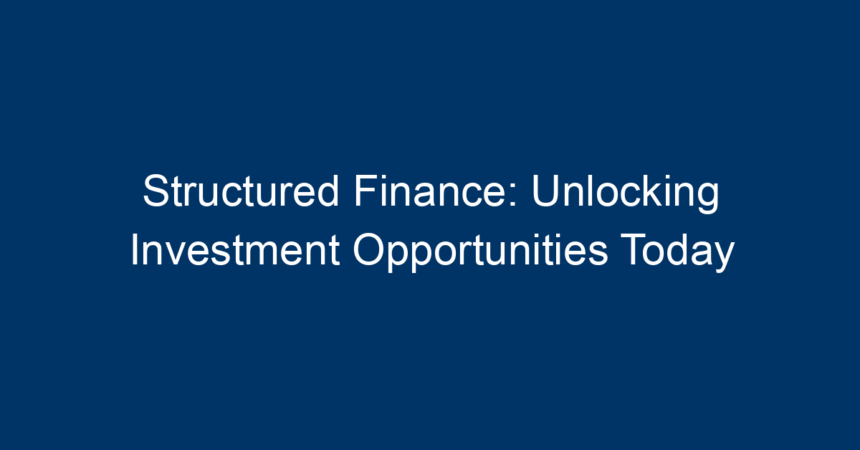In an ever-evolving financial landscape, structured finance is emerging as a crucial instrument for businesses and investors alike. As traditional funding avenues become increasingly competitive and complex, structured finance offers creative solutions that can unlock significant investment opportunities. This article delves deep into structured finance—its definition, benefits, types, and how it can be leveraged for improved investment returns.
What is Structured Finance?
Structured finance refers to a sophisticated financial process that involves pooling various financial assets to create investment vehicles that can be sold to investors. This method is predominantly utilized to manage risk and finance large-scale projects, involving a combination of debt and equity transactions. Unlike standard financing options, structured finance solutions are tailored to meet specific needs of businesses, enabling them to optimize their capital structure.
Key Components of Structured Finance
-
Asset-Backed Securities (ABS): These are financial securities backed by a pool of assets, such as loans, leases, and receivables. Investors receive cash flows derived from these underlying assets.
-
Collaterized Debt Obligations (CDOs): CDOs are another form of structured finance wherein various types of debt are pooled together, often including mortgage-backed securities, and sold in tranches to different investors based on their risk profiles.
- Securitization: This process entails converting illiquid assets into securities that can be traded on financial markets, providing liquidity and enabling better risk management.
By leveraging these key components, investors can navigate the complexities of structured finance to maximize their returns.
Benefits of Structured Finance
1. Risk Management
One of the most significant advantages of structured finance is its ability to manage risk effectively. Through techniques such as securitization, credit enhancements, and risk transfer mechanisms, investors can mitigate exposure to various financial risks. For example, by pooling assets, firms can create diversified portfolios that reduce the volatility of returns.
2. Enhanced Liquidity
Structured finance enables access to capital markets that may otherwise be closed off to individual investors or smaller companies. By converting illiquid assets into liquid securities, businesses can raise funds without having to divest core operations. This enhanced liquidity can bolster balance sheets and support ongoing growth initiatives.
3. Customization
Structured finance offers a degree of customization that is hard to achieve with traditional financing solutions. Investors can tailor structured finance offerings based on their specific risk appetites, investment horizons, and return expectations. This flexibility enables businesses to secure the financing they need while appealing to the preferences of various investors.
4. Access to Diverse Investment Opportunities
Structured finance opens avenues for diversification by providing access to unique asset classes. For instance, investing in CDOs allows investors to gain exposure to a variety of underlying assets—ranging from residential mortgages to corporate loans—without directly purchasing them. This exposure helps in diversifying risk across several sectors.
Types of Structured Finance Instruments
Structured finance encompasses numerous forms of financial instruments. Let’s explore some of the predominant types.
1. Mortgage-Backed Securities (MBS)
Mortgage-backed securities are one of the most well-known forms of structured finance. They pool various mortgage loans and sell shares of this pool to investors. MBS can provide a consistent income stream backed by the repayment of mortgage loans, making them an attractive investment opportunity.
2. Asset-Backed Commercial Paper (ABCP)
ABCP is a short-term investment vehicle that is backed by a pool of receivables. It allows companies to generate funding by issuing commercial paper backed by assets. This can be particularly useful for firms looking to manage working capital timely and efficiently.
3. Synthetic CDOs
Unlike traditional CDOs, which are backed by actual assets, synthetic CDOs use credit derivatives to achieve investment returns. They offer exposure to a portfolio of reference entities without directly owning the underlying assets. This enables investors to take complex positions in the credit market.
4. CLOs (Collateralized Loan Obligations)
CLOs are structured finance instruments that pool various loans—typically leveraged loans—to create a diversified portfolio. They are often divided into different tranches, each with unique risk and return profiles, making them a potent investment tool for those seeking yield opportunities.
How to Leverage Structured Finance for Investment Growth
Investors looking to harness the potential of structured finance can adopt several strategies:
1. Understand Your Risk Tolerance
Before diving into structured finance, it’s vital to assess your individual risk profile. Understand what level of risk you are comfortable with, and choose structured finance instruments accordingly. Moreover, always keep in mind the possibility of total loss, especially with higher-risk tranches.
2. Diversify Your Portfolio
Incorporate a mix of structured finance instruments to create a balanced investment portfolio. This diversification can help mitigate the risk of losses from any one investment, ensuring a more stable return over time.
3. Keep Abreast of Market Trends
The structured finance market is constantly changing. Stay updated with financial news, subscription reports, and industry conferences to understand the latest trends and innovations. This will help you make informed investment decisions.
4. Leverage Professional Insight
Enlisting the help of consultants, financial advisors, or even joining investment clubs can provide valuable insights into structured finance products. Expert guidance can help you navigate complex products and tailor an investment strategy aligned with your goals.
Conclusion: Structured Finance—The Future of Investment Opportunities
Structured finance is carving a niche by unlocking various investment opportunities in a complex and competitive landscape. With its risk management capabilities, enhanced liquidity, customization options, and diverse investment avenues, it stands as a robust solution for both companies and investors.
As you consider integrating structured finance into your investment strategy, remember to assess your risk tolerance, diversify your portfolio, stay informed about market trends, and seek expert insights. By doing so, you can unlock the potential benefits of structured finance and position yourself for success in today’s investment landscape.
With structured finance, the future of your investment opportunities is not just promising—it’s here and ripe for exploration.




